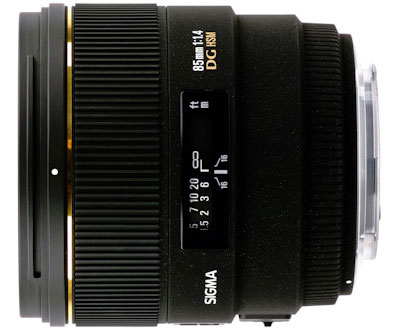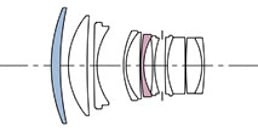Sigma 85mm f1.4 EX review
-
-
Written by Thomas
Intro
The Sigma AF 85mm f/1.4 EX DG HSM is a short telephoto lens with a bright f1.4 focal ratio. Announced February 2010, it’s the only 85mm large aperture alternative to Nikon or Canon’s own primes that offers auto-focus. The short telephoto lenses from Samyang and Zeiss are manual focus only. It is available for Canon, Nikon, Sigma, Sony, and Pentax mounts.
Sigma has priced its 85mm f1.4 lens in-between the budget and high-end 85mm options from both Canon and Nikon. So it’s more expensive than the Canon and Nikon f1.8 models, but comfortably cheaper than the Canon f1.2 and Nikon f1.4 versions. As such anyone considering buying either of the big-brand options will naturally be wondering how the Sigma compares.
On both cropped and full-frame bodies the 85mm focal length is considered a preferred candidate for portrait-photography as it gives you some distance from your subject which leads to a flattering perspective. This, combined with the capability to render blurred backgrounds with a smooth bokeh, makes large aperture 85mm lenses very sought after. Another use-case for 85mm primes is street-photography where you need some reach and a fast shutter speed. But 85mm lenses may also be used for nature photography and capturing landscapes.
In this review I’ve taken a detailed look at Sigma’s 85mm f1.4 prime to find out whether it can deliver the goods. To really push it to the limits I tested the Nikon F-mount version with a 36 Megapixel full-frame Nikon D800, although my results and conclusions are equally applicable to other mounts and systems.
 |
Facts from the catalog
Here’s the usual look at the technical data first with some comparison to its prime competitor for Nikon DSLRs, the Nikon AF-S 85mm f1.4G. I’ve rated the features with a [+] (or [++]), when it’s better than average or even state of the art, a [0] if it’s standard or just average, and [-] if there’s a disadvantage.
 | |
Size (diam. x length): 85 x 88 mm (3.3 x 3.5 in.). This is not a small lens, but of similar size to the Nikon equivalent. It still fits harmoniously on a larger APS-C or FF-/FX-body. [0]
Weight: 719 g (25.4 oz) = 124 grams heavier than Nikon’s. [0]
Optics: 11 elements in 8 groups vs. 10 elements in 9 groups on Nikon’s 85/1.4G. This is still a small amount of glass compared to zooms that tend to have something like 21/16. That bodes well for contrast and flare-resistance. Sigma used two special glass-elements in this construction. [0]
Closest focus distance/max. magnification: 0.85 m (2.8 ft.) / 1:8.6. This does not come close to what I often need in nature (1:3-1:5). So no honorable mention for this performance, but other 85mm lenses don’t focus closer either. When using a 2 diopter close-up filter (like the very good Canon 500D) you could reach a magnification around and beyond 1:5.8. [0]
Filter-thread: 77mm = standard with larger pro-lenses [+]
IS: No = a pity! Many zooms covering 85mm as well as the Sigma 105/2.8 macro lens have OS. You can only hope that with a 2 stops larger aperture you could crank up the shutter speed to where shake is less likely. And shake you see: Just look through the viewfinder! [–]
AF: AF with HSM (hyper sonic motor), so it does work on D60/3×00/5×00-bodies or Canon bodies w/o AF-motor, manual-focus override by turning the focus ring [+]
Covers full frame/FX or smaller = very good [+]
Comes with a nice soft-case that protects the lens better against banging around than the flimsy pouches that Nikon supplies. [+]
Price: around 860 EUR new (incl. 19% VAT) = much cheaper than Nikon’s 85/1.4G at around 1400 EUR. Canon’s EF 85mm 1.2 II L USM is around 1900 EUR but offers 1/3 of a stop larger aperture. [0]
The lens-caps are almost like standard Nikon’s but the rear cap still can only be screwed on in exactly one position – not three like with Nikon’s. [0] Lens-shade included and reversible for transport plus there is a APS-C/DX hood-extender that adds 3.5 cm to the hood for extra protection against light. [+]
Distance information is relayed to the camera, so the Nikon body can do all the advanced exposure-related stuff with this lens. But this is true for all the alternatives too. [+]
Aperture ring = no, just like all modern lenses. [0]
Sealing: no. [0]
So the score in the “features-department” is 2[-]/8[0]/6[+].
Motivation
:
Large aperture 85mm lenses are for isolating your subject from some distance and/or getting faster shutter speeds when your subjects are moving. But I can use this as a nature shooter too because I love not having everything in equal sharpness.
Alternatives
:
For getting at least f1.4 at 85mm there are really only four alternatives for Nikon users (and 3 for Canon users). But only 2 (resp. 1) offer AF:
– The old Nikkor AF 85/1.4D, can still be had, just a little more expensive, but supplanted by…
– The new Nikkor AF-S 85/1.4G which is much more expensive but provides excellent performance (see my Nikon AF-S 85/1.4G review)
– The Zeiss ZF.2 Planar T* 85mm 1.4 (manual focus only)
– The Samyang AE 85mm 1.4 Asph IF (manual focus only)
– The Canon EF 85mm 1.2 II L USM, which offers 1/3 of a stop larger aperture at more than double the price.
Or you go for the cheaper f1.8 lenses from Nikon (see my review of the excellent Nikon AF-S 85/1.8G) or Canon.
 The Sigma AF 85/1.4 EX DG HSM delivers a very good performance and is actually the cheapest 85mm f1.4 lens with AF. In some aspects its image quality reaches Nikon's AF-S 85/1.4G - at 60% of the price. My upcoming 85mm shootout will give you a detailed comparison.
The Sigma AF 85/1.4 EX DG HSM delivers a very good performance and is actually the cheapest 85mm f1.4 lens with AF. In some aspects its image quality reaches Nikon's AF-S 85/1.4G - at 60% of the price. My upcoming 85mm shootout will give you a detailed comparison.


